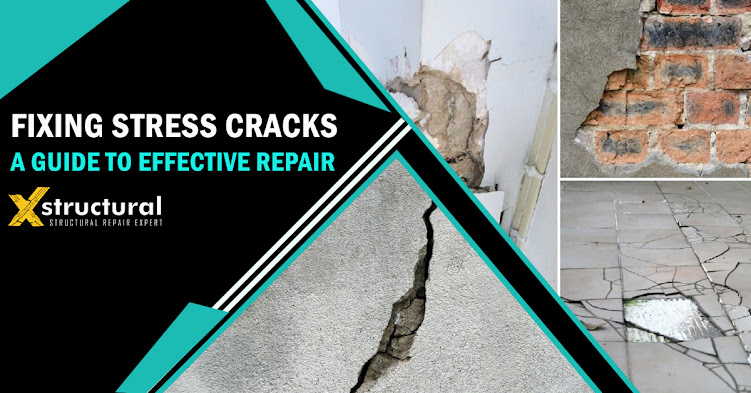Fixing Stress Cracks: A Guide to Effective Repair
Stress cracks can occur in a variety of materials, from concrete to wood, and can be caused by a range of factors including temperature changes, humidity, and physical stress. They can be unsightly and, if left unattended, can lead to more serious structural issues. However, repairing stress cracks is a relatively simple process that can be done by anyone with the right tools and knowledge. In this article, we will provide a step-by-step guide to repairing stress cracks effectively.
1. Understanding Stress Cracks
Stress cracks are caused by forces that exceed the material's ability to handle them. These forces can come from a range of sources, including temperature changes, humidity, and physical stress. For example, concrete can crack due to expansion and contraction caused by temperature changes. Wood can crack due to changes in humidity or because of the weight it's supporting. Stress cracks can also be caused by settling, vibration, or other physical forces.
2. Identifying Stress Cracks
Identifying stress cracks is the first step in repairing them. Stress cracks often have a jagged or irregular shape, and they can be seen as a visible line on the surface of the material. The crack may be wider on one end than the other, and it may be accompanied by a bulge or depression in the surface. If the crack is large enough, it may also be accompanied by a sound or vibration when pressure is applied to the material.
3. Tools Required for Repairing Stress Cracks
To repair stress cracks, you will need a few tools. These include a putty knife, sandpaper, a wire brush, a caulking gun, and a stress crack filler. The type of filler you use will depend on the material you're repairing. For example, if you're repairing a concrete stress crack, you'll need a concrete filler. If you're repairing a wood stress crack, you'll need a wood filler.
4. Preparing the Area
Before you begin repairing the stress crack, you need to prepare the area. This includes removing any loose debris, cleaning the area with a wire brush or sandpaper, and ensuring the area is dry and free of dust or dirt. You may also want to use a primer to ensure the filler adheres properly to the surface.
Also read for, Get Your Structure Strong Again: Call Xstructural for Top-notch Steel Repair Services
5. Filling the Crack
Once the area is prepared, you can begin filling the crack. Use a caulking gun to apply the filler, starting at one end of the crack and working your way to the other end. Be sure to fill the entire crack, pushing the filler into any crevices or gaps. If the crack is deep, you may need to apply several layers of filler, allowing each layer to dry before applying the next.
6. Smoothing the Surface
After you've filled the crack, use a putty knife to smooth the surface of the filler. Be sure to remove any excess filler, and make sure the surface is flush with the surrounding material. You may also want to use a damp cloth to smooth the surface and remove any remaining debris.
7. Letting the Filler Dry
The filler needs to dry completely before you move on to the next step. The drying time will vary depending on the type of filler you're using and the temperature and humidity in the room. Follow the manufacturer's instructions for the recommended drying time.
8. Sanding the Surface
Once the filler is completely dry, use sandpaper to smooth the surface. Start with a coarse grit sandpaper and work your way up to a finer grit. Sand until the surface is smooth and level with the surrounding material.
9. Painting or Sealing the Surface
If necessary, you can paint or seal the surface to match the surrounding material. Be sure to use a paint or sealant that's compatible with the filler you used. Follow the manufacturer's instructions for application and drying time.
10. Prevention Tips
To prevent stress cracks from occurring in the future, there are a few things you can do. For example, you can use expansion joints or control joints to allow for movement in materials like concrete. You can also avoid exposing materials to extreme temperatures or humidity, and make sure they're installed properly.
11. When to Call in a Professional
While repairing stress cracks is a relatively simple process, there may be situations where you need to call in a professional. For example, if the crack is very large or if it's a structural issue, you should contact a professional.
12. Common Mistakes to Avoid
There are a few common mistakes people make when repairing stress cracks. One is not filling the crack completely, which can lead to further cracking. Another is using the wrong type of filler, which can cause the repair to fail. Be sure to follow the manufacturer's instructions and choose the right type of filler for the job.
Also read for, Everything You Need to Know About Lally Column
13. Frequently Asked Questions
Q. Can stress cracks be repaired?
Yes, stress cracks can be repaired using the right tools and knowledge.
Q. How do I know if a crack is a stress crack?
Stress cracks often have a jagged or irregular shape and can be seen as a visible line on the surface of the material.
Q. What tools do I need to repair stress cracks?
You will need a putty knife, sandpaper, a wire brush, a caulking gun, and a stress crack filler.
Q. How long does it take for stress crack filler to dry?
The drying time will vary depending on the type of filler you're using and the temperature and humidity in the room. Follow the manufacturer's instructions for the recommended drying time.
Q. Can stress cracks be prevented?
Yes, stress cracks can be prevented by using expansion joints or control joints, avoiding extreme temperatures or humidity, and installing materials properly.
14. Conclusion
In conclusion, repairing stress cracks is a relatively simple process that can be done by anyone with the right tools and knowledge. By following the steps outlined in this article, you can effectively repair stress cracks and prevent them from becoming a more serious issue. If you're unsure about your ability to repair stress cracks, it's always best to consult a professional. For more information on repairing stress cracks or for assistance with any structural issues, visit XStructural at xstructural.com.



Comments
Post a Comment